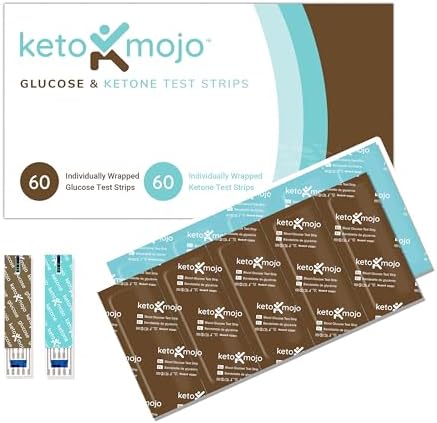Is Keto Safe for Diabetics: Exploring Health Impacts and Considerations
This post may contain affiliate links. If you purchase through these links, I may earn a small commission at no extra cost to you. LEARN MORE.
For individuals managing diabetes, dietary choices are crucial in maintaining stable blood sugar levels and overall health.
The ketogenic diet, known for its low-carb and high-fat ratio, has caught the attention of many for this purpose.
The keto diet can be safe and effective for some people with diabetes, helping manage blood sugar levels by significantly reducing carbohydrate intake.

By shifting the body’s fuel source from carbohydrates to fats, the ketogenic diet may aid in blood sugar control, which is a constant challenge for diabetics.
Historical use of this diet as a diabetes management tool supports its potential benefits, although it should be approached with careful planning and consideration of individual health needs.
For those considering this dietary change, exploring personalized plans and recipes can enhance adherence and safety.
Monitoring nutritional intake ensures that the diet remains balanced and nutritious.
The article will delve into these aspects, providing comprehensive insights for those considering this dietary pathway.
Key Takeaways
- Keto can help manage diabetes by reducing carbs.
- Personalized meal planning is key for keto success.
- Nutritional balance ensures keto diet safety.
Understanding the Keto Diet

The keto diet is characterized by its low-carbohydrate and high-fat content. This approach can significantly alter the body’s metabolic process and has been studied for its potential effects on diabetic patients.
Basics of the Keto Diet
The keto diet focuses on drastically reducing carbohydrate intake while increasing fat consumption.
Typically, the breakdown involves consuming about 75% to 80% fats, 10% to 15% protein, and 5% to 10% carbohydrates.
This nutritional shift encourages the body to use fat as the primary energy source.
Carbohydrates are minimized, which means foods like bread, pasta, and sugar are limited.
Instead, meals predominantly consist of fatty fish, avocados, eggs, nuts, and oils. Proteins such as meats and cheese also play a significant role.
Keto Diet Variations
There are several variations of the keto diet, each differing slightly in composition.
The Standard Ketogenic Diet (SKD) is the most common, following the traditional division of macronutrients.
Other versions include the Cyclical Ketogenic Diet (CKD), which alternates periods of low-carb intake with high-carb ‘refeeds’, and the Targeted Ketogenic Diet (TKD), which allows more carbs around workouts.
Each variation is tailored to specific needs and tolerances, offering flexibility while maintaining keto principles.
How the Keto Diet Works
The keto diet operates on the principle of ketosis.
By restricting carbs, the body shifts from using glucose as its primary fuel source to breaking down fats into ketones.
Ketones provide an alternative energy source. This metabolic shift is central to the function of the diet.
For diabetics, this process can lead to more stable blood sugar levels as carbohydrate intake directly influences blood glucose.
Regular monitoring and consultation with healthcare providers are crucial for those with diabetes considering this diet approach.
Keto Diet and Diabetes Management

The ketogenic diet, which involves a high-fat, low-carbohydrate intake, has gained attention for its potential benefits in managing diabetes. This approach focuses on stabilizing blood sugar levels and improving insulin sensitivity.
The Impact of Ketogenic Eating on Blood Sugar
Ketogenic eating significantly reduces carbohydrate intake, which can lead to lower blood sugar levels.
For individuals with diabetes, managing blood sugar is critical, and the keto diet can be an effective approach.
By predominantly consuming fats, the body enters a state called ketosis, burning fat for fuel instead of glucose.
This helps minimize blood sugar spikes after meals, potentially improving glycemic control.
Foods like avocados, nuts, and olive oil are popular choices as they offer healthy fats without the carbs that raise blood sugar. Monitoring is crucial as individual responses can vary.
Is Keto Safe for Diabetics
For some diabetics, particularly those with Type 2 diabetes, the keto diet may aid in blood sugar management and weight loss.
Weight reduction often translates into better insulin sensitivity. Studies suggest that a well-implemented keto diet can improve glycemic control, minimizing insulin requirements for some people.
Care must be taken to avoid potential pitfalls like nutrient deficiencies or diabetic ketoacidosis, a serious condition where ketone levels become dangerously high.
Before starting, consulting with healthcare professionals to tailor the diet to individual needs ensures a safe transition.
Incorporating nutrient-dense foods such as leafy greens, fish, and eggs helps maintain nutritional balance while following the ketogenic approach.
Use these tools to help to monitor blood glucose and ketone levels.
Creating a Customized Keto Plan

A personalized keto diet offers tailored strategies that cater to individual health needs and lifestyle preferences. This approach can optimize the benefits of a low-carb diet while ensuring safety and practicality for people with diabetes.
Benefits of a Personalized Approach
A customized keto diet can significantly aid in managing diabetes by targeting specific dietary needs.
Each individual’s metabolic rate, lifestyle, and preferences are considered, providing a diet plan that effectively manages carbohydrate intake.
Personalized plans can improve blood sugar control. By focusing on meals that align with a person’s daily routine and food preferences, adherence to the diet is often easier and more sustainable over the long term.
This approach allows continual monitoring and adjustments. Regular assessments enable the individual and healthcare provider to make necessary changes, enhancing the effectiveness of the diet plan.
How to Create Your Custom Keto Diet Plan
Creating a customized keto diet plan involves a combination of self-assessment and professional guidance.
Begin by conducting a custom keto diet quiz to gather insights into your dietary habits and health goals.
Work closely with healthcare professionals, such as a dietitian or endocrinologist. They can help determine the appropriate macronutrient balance, ensuring nutrient requirements are met.
Incorporate a meal plan that incorporates a variety of low-carb, high-fat foods suitable for individuals with diabetes.
Consulting resources and tools that offer a custom keto diet plan can streamline this process and provide a structured framework for dietary choices.
Finally, engage in regular follow-ups to assess the plan’s effectiveness and make necessary corrections.
Adjustments may be needed based on changes in health status or lifestyle.
Meal Planning and Recipes

Meal planning is crucial for diabetics considering the keto diet, as precise carb control helps manage blood sugar levels. Crafting meals that balance low-carb, healthy fats with moderate protein intake is key.
Sample Keto Diet Meals
Creating a varied keto diet menu can help in maintaining interest and nutritional balance.
A typical day might start with a keto diet breakfast featuring scrambled eggs cooked in butter, paired with spinach and a side of avocado.
For lunch, a mixed green salad with grilled chicken, cherry tomatoes, and feta cheese is both satisfying and nutrient-rich.
Dinner can include slow-cooker braised beef with carrots and turnips, a low-carb meal that remains hearty while fitting within keto guidelines.
Snacks such as almonds or a hard-boiled egg are excellent low-carb options to maintain energy levels and keep hunger at bay throughout the day.
Preparing Keto-Friendly Foods
Crafting a keto diet meal plan involves carefully selecting items from a keto diet food list during grocery shopping.
Essential items include avocado, nuts, seeds, leafy greens, and meats.
A comprehensive keto diet grocery list can streamline shopping, ensuring all necessary ingredients for your meals are on hand.
When preparing meals, cooking techniques such as baking, grilling, and steaming can preserve nutrients and enhance flavors.
Utilizing herbs and spices instead of high-carb sauces maximizes taste without exceeding carb limits.
Prepping ingredients in advance helps manage time efficiently, especially during busy weekdays, ensuring adherence to the dietary plan is convenient and sustainable.
Safety and Nutrition on a Keto Diet

The ketogenic diet has attracted interest for managing diabetes, promising benefits like improved glycemic control and weight loss. Ensuring balanced nutrition is essential to avoid potential health risks.
Maintaining Balanced Nutrition
A keto diet focuses on high-fat, low-carbohydrate meals, which can be challenging to balance nutritionally.
Essential nutrients might be lacking due to limited food variety.
Incorporating nutritious, low-carb vegetables like spinach and broccoli is key.
Including sources of healthy fats—avocado, nuts, and seeds—can improve diet quality.
For those following a vegetarian keto diet, protein intake can be maintained with foods like tofu, tempeh, and cheese.
Careful planning ensures vital micronutrients such as potassium, magnesium, and vitamins are not overlooked.
Potential Risks and How to Mitigate Them
The keto diet presents health risks like nutrient deficiencies, liver concerns, and ketoacidosis risks, especially for diabetics.
Nutrient deficiencies can arise from narrow food choices. Monitoring macronutrient intake and consulting experts aids in maintaining nutrient balance.
Ketoacidosis risk is particularly worrying for type 1 diabetics. Regularly checking blood glucose and ketone levels is critical.
Incorporating blood tests and healthcare advice can prevent complications.
Frequently Asked Questions
A ketogenic diet can have varied impacts on individuals with diabetes, affecting factors like blood sugar control and cholesterol levels. Specific considerations must be taken into account to ensure safety and effectiveness.
Can a ketogenic diet lead to ketoacidosis in diabetic patients?
Ketoacidosis is a serious condition that can occur if ketone levels in the blood become too high.
People with diabetes, particularly type 1, need to monitor ketone levels carefully. While most on a keto diet do not reach dangerous levels, diabetic individuals are at higher risk.
How does a ketogenic diet affect blood sugar control in type 1 diabetes?
Those with type 1 diabetes may see improved blood sugar control with reduced carbohydrate intake. However, insulin management remains crucial.
Maintaining appropriate insulin use while on a keto diet helps prevent both high and low blood sugar episodes.
What are the potential benefits of a keto diet for individuals with type 2 diabetes and high cholesterol?
For those with type 2 diabetes, a keto diet may support improved blood sugar levels and weight management.
There is potential for improving cholesterol profiles, but monitoring by healthcare providers is advised to ensure lipid levels do not increase.
What type of menu plan should diabetics follow on a keto diet?
A keto-friendly menu plan for diabetics should emphasize low-carb, high-fat foods like leafy greens, nuts, seeds, and healthy oils.
Portion control and awareness of carbohydrate content help in maintaining stable blood sugar levels.
Can a ketogenic diet help in managing or reversing prediabetes conditions?
Prediabetes management may benefit from a keto diet through enhanced insulin sensitivity and weight loss.
Reduction of carbohydrate intake could help lower fasting blood sugar levels, potentially preventing the progression to type 2 diabetes.
Are there specific risks associated with a low-carb diet for individuals with type 2 diabetes?
Hypoglycemia, or low blood sugar, can be a significant risk for type 2 diabetics on a low-carb diet.
Regular monitoring of blood sugar and potential medication adjustments by healthcare providers are critical to mitigate this risk.


